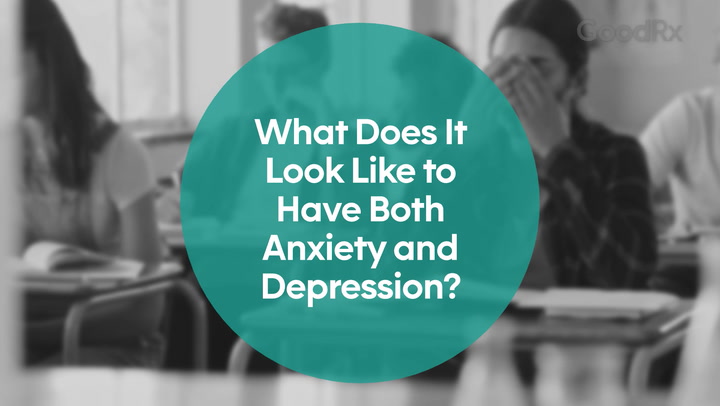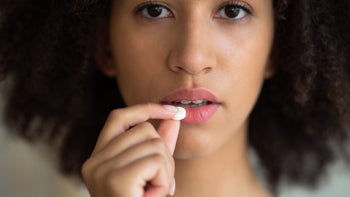
Prozac vs. Zoloft: How Do They Compare for Anxiety?
Key takeaways:
Prozac (fluoxetine) and Zoloft (sertraline) are in a group of medications called selective serotonin reuptake inhibitors (SSRIs). They treat many mental health conditions, including anxiety disorders.
When comparing Prozac versus Zoloft, they’re likely equally effective for generalized anxiety disorder and panic disorder. But Zoloft may be more effective for social anxiety disorder.
Prozac and Zoloft have similar side effects. But Prozac is known to have more interactions.
Table of contents

We all get a little anxious from time to time. From sweaty palms on a first date to knocking knees before a big presentation — these are normal responses to stress.
But if feelings of anxiety regularly interfere with your daily life, it’s important to check in with your healthcare provider. If they believe you have an anxiety disorder, you’ll have many treatment options. This includes “talk therapy” (psychotherapy), lifestyle changes, and/or medications.
Zoloft (sertraline) and Prozac (fluoxetine) are two medications commonly prescribed for anxiety. They’re part of the same group of medications and have some similarities. But they have many differences, too.
Search and compare options
What’s Prozac?
Prozac belongs to a group of medications called selective serotonin reuptake inhibitors (SSRIs). Of the anxiety disorders, Prozac is only approved to treat panic disorder. But even though Prozac isn’t officially approved for other anxiety disorders, it’s often used off-label for generalized anxiety disorder (GAD) and others.
Prozac is approved to treat other mental health conditions, however. These include obsessive compulsive disorder (OCD), major depressive disorder (MDD), and bulimia nervosa.
Prozac is also combined with olanzapine in a pill called Symbyax. This combination pill is approved to treat depression symptoms in people with bipolar disorder and treatment-resistant depression.
What’s Zoloft?
Like Zoloft, Prozac is an SSRI. It’s FDA approved to treat two types of anxiety disorders: panic disorder and social anxiety disorder.
It’s also approved to treat other mental health conditions, including OCD, MDD, and post-traumatic stress disorder (PTSD). Zoloft isn’t FDA approved to treat GAD. But it’s sometimes used off-label for this reason.
How do Prozac and Zoloft work for anxiety?
SSRIs like Prozac and Zoloft increase serotonin levels in the brain. Serotonin is a natural chemical in your body. It acts as a “messenger” that transports chemical messages between your nerves. This is thought to help regulate many bodily functions, including your sleep, digestion, and mood.
Many experts believe that low serotonin levels are associated with anxiety. But experts aren’t completely sure just how significant serotonin’s role in anxiety is. Other factors, like your brain structure and even your gut microbiome, may play a role. But for now, we know that SSRIs improve anxiety-related symptoms in many people who take them.
How are Prozac and Zoloft dosed?
Prozac and Zoloft both come in multiple forms that are taken by mouth. But there are some differences you should know about.
Prozac
Prozac comes in the following forms, which are all available as generics:
Tablets: 10 mg, 20 mg, 60 mg
Capsules: 10 mg, 20 mg, 40 mg
Liquid solution: 20 mg/5 mL
Delayed-release (DR) capsules: 90 mg
The DR capsules are only taken once a week. Other forms of Prozac are usually taken once daily in the morning, with or without food. If you’re taking a higher dose, you may have to take two doses per day. Taking it with food may help prevent stomach upset, a common side effect of Prozac.
The starting dose of Prozac for panic disorder is usually 10 mg per day. For other conditions, it ranges between 20 mg to 60 mg per day. Your healthcare provider may increase the dose every several days to weeks. The maximum dose is usually between 60 mg to 80 mg per day.
Zoloft
Zoloft is usually taken once daily, with or without food. Like Prozac, taking it with food may help prevent an upset stomach. It comes in the following forms, which are all available as a generic:
Capsules: 150 mg, 200 mg
Tablets: 25 mg, 50 mg, and 100 mg
Liquid solution: 20 mg/mL
The starting dose of Zoloft is usually 25 mg daily for panic disorder. It’s between 25 to 50 mg for other mental health conditions. Your healthcare provider may increase your dose by 25 to 50 mg on a weekly basis. The maximum dose is 200 mg per day for most health conditions.
If you’re taking the liquid solution, you should mix it with 4 oz of liquid right before you take it. If you don’t mix Zoloft solution with liquid, it can numb your mouth and tongue for over a day. Water, ginger ale, and lemonade are all options for diluting the medication.
How effective are Prozac and Zoloft for treating anxiety?
Prozac and Zoloft are both effective at treating anxiety. You may notice an improvement in your anxiety in as little as 2 weeks. But since your healthcare provider may increase your dose over several weeks, it can take 1 to 2 months before you feel full effects.
Prozac has been shown to improve symptoms of anxiety in panic disorder and GAD. Its effectiveness for treating SAD is unclear.
Zoloft is also known to improve symptoms of panic disorder, SAD, and GAD.
Is Prozac or Zoloft better for anxiety?
There are few studies directly comparing Prozac versus Zoloft for anxiety. But let’s discuss what research is available:
A review of over 87 studies compared multiple SSRIs for the treatment of panic disorder. Zoloft was one of the most effective SSRIs with the lowest risk of side effects. Prozac was also effective but had a higher risk of side effects.
A review of 27 randomized controlled trials (the best type of study to check for cause and effect) found that Prozac may be the most effective SSRI at treating GAD. But the study found that Zoloft may have the least amount of side effects.
A study comparing Prozac, Zoloft, and Paxil (paroxetine) in people with depression and high levels of anxiety found that these SSRIs worked similarly well and were well-tolerated.
Prozac is considered less effective than other SSRIs at treating SAD. Some studies have found that Prozac isn’t more effective than placebo (a pill with nothing in it) at treating SAD. But multiple studies have shown that Zoloft is more effective than placebo.
So, what’s the verdict? For GAD and panic disorder, Prozac and Zoloft are similarly effective. For treating SAD, it’s likely that Zoloft is a better option.
What are the side effects of Prozac and Zoloft?
Prozac and Zoloft share common side effects. But there are some differences, too. In clinical studies, people using Prozac to treat panic disorder were most likely to experience:
Nausea
Diarrhea
Insomnia
Nervousness
In studies of people using Zoloft, the most common side effects were:
Nausea
Diarrhea
Trouble sleeping
Dry mouth
Tiredness
Dizziness
Other common side effects of both Prozac and Zoloft include headache, changes in appetite, and sexual dysfunction (like ejaculation problems and low sex drive). While most of these side effects improve over time, sexual side effects may last for the duration of treatment.
For more detailed information on Prozac and Zoloft side effects, check out our other articles on these topics.
What are the serious side effects of Prozac and Zoloft?
All SSRIs, including Prozac and Zoloft, have a boxed warning for the risk of suicidal thoughts and behaviors. Boxed warnings are the highest warning the FDA can give a medication. The risk may be highest in people who are less than 25 years of age.
Other rare but serious side effects of Prozac and Zoloft include:
Abnormal heart rhythms
Manic episodes (intense feelings of energy) in people with bipolar disorder
Higher risk of bleeding
Dangerously high serotonin levels (serotonin syndrome)
Antidepressant discontinuation syndrome if you abruptly stop Zoloft or Prozac
What interactions do Prozac and Zoloft have?
Both Prozac and Zoloft have interactions. In general, Prozac has more interactions than Zoloft.
Prozac and Zoloft can increase the levels of some other medications. And this may lead to increased side effects. Examples include:
Some antiarrhythmics, like propafenone (Rythmol) and flecainide
Beta blockers, like metoprolol (Lopressor, Toprol XL) and nebivolol (Bystolic)
Some tricyclic antidepressants (TCAs), like imipramine (Tofranil) and desipramine (Norpramin)
Dextromethorphan (Delsym)
Other medications that have similar risks as Prozac and Zoloft can also interact. When combined, the risk of side effects is increased. This includes:
Medications that increase serotonin levels, like many other antidepressants, triptans, and tramadol (Ultram, ConZip)
Medications that can cause abnormal heart rhythms, like quinidine and methadone (Methadose)
Medications that can cause bleeding, like nonsteroidal anti-inflammatory drugs (NSAIDs) and anticoagulants
Prozac may also interact with medications that are considered narrow therapeutic index drugs. These are medications that can become easily toxic at slightly high doses. These include lithium (Lithobid), digoxin (Lanoxin, Digitek), and phenytoin (Dilantin, Phenytek).
Certain medications shouldn’t be used with Prozac or Zoloft at all. These include pimozide and monoamine oxidase inhibitors (MAOIs). If you’re taking an MAOI, it should be stopped at least 2 weeks before starting Prozac or Zoloft. And thioridazine also shouldn’t be used within 5 weeks of Prozac use. But don’t make any changes without talking to your healthcare provider first.
Keep in mind this isn’t a complete list of possible interactions with Prozac and Zoloft. It’s a good idea to have your pharmacist or provider check for any potential interactions. Giving them an updated list of your medications will help them check.
Can you take Prozac and Zoloft together for anxiety?
No. Prozac and Zoloft work in the same way to relieve anxiety. Taking them together may increase the risk of side effects.
Ways to save on Prozac and Zoloft
Prozac and Zoloft are available as brand-name medications. But you can also find them as lower-cost generics. Generic Prozac’s price at certain pharmacies is less than $11 with a free GoodRx discount. Generic Zoloft's price at certain pharmacies is less than $10 with a free GoodRx discount.
The bottom line
Prozac and Zoloft are both SSRI medications that can treat anxiety disorders. Both medications are approved for panic disorder and are likely equally effective. Neither medication is approved for GAD, but are considered first-choice treatments for this condition. They seem to be equally effective for GAD. However, Zoloft is likely more effective than Prozac for SAD.
Both medications have similar side effects, though Prozac is known to have more interactions. If you have any questions about Prozac versus Zoloft, and which SSRI might be right for you, talk to your healthcare provider. They can help you make a decision based on individual factors, including your medical history and personal preferences.
Why trust our experts?



References
Albert, P. R., et al. (2014). Serotonin-prefrontal cortical circuitry in anxiety and depression phenotypes: Pivotal role of pre- and post-synaptic 5-HT1A receptor expression. Frontiers in Behavioral Neuroscience.
Allgulander, C., et al. (2015). Efficacy of sertraline in a 12-week trial for generalized anxiety disorder. The American Journal of Psychiatry.
Almatica Pharma LLC. (2021). Sertraline hydrochloride [package insert].
Anxiety & Depression Association of America. (2015). Clinical practice review for GAD.
Baldwin, D., et al. (2011). Efficacy of drug treatments for generalised anxiety disorder: Systematic review and meta-analysis. British Medical Journal.
Blanco, C., et al. (2013). The evidence-based pharmacotherapy of social anxiety disorder. International Journal of Neuropsychopharmacology.
Chawla, N., et al. (2021). Drug treatment for panic disorder with or without agoraphobia: Systematic review and network meta-analysis of randomised controlled trials. British Medical Journal.
Farach, F. J., et al. (2012). Pharmacological treatment of anxiety disorders: Current treatments and future directions. Journal of Anxiety Disorders.
Fava, M., et al. (2000). Fluoxetine versus sertraline and paroxetine in major depression: Tolerability and efficacy in anxious depression. Journal of Affective Disorders.
Garakani, A., et al. (2020). Pharmacotherapy of anxiety disorders: Current and emerging treatment options. Frontiers in Psychiatry.
Gomez, A. F., et al. (2020). SSRIs and benzodiazepines for general anxiety disorders (GAD). Anxiety & Depression Association of America.
Kobak, K. A., et al. (2002). Fluoxetine in social phobia: A double-blind, placebo-controlled pilot study. Journal of Clinical Psychopharmacology.
Preferred Pharmaceuticals Inc. (2022). Sertraline hydrochloride [package insert].
Remedyrepack Inc. (2022). Fluoxetine [package insert].
Sohel, A. J., et al. (2022). Fluoxetine. StatPearls.
U.S. Food and Drug Administration. (2017). FY2015 regulatory science research report: Narrow therapeutic index drugs.
Yang, B., e tal. (2019). Effects of regulating intestinal microbiota on anxiety symptoms: A systematic review. British Medical Journal.
For additional resources or to connect with mental health services in your area, call SAMHSA’s National Helpline at 1-800-662-4357. For immediate assistance, call the National Suicide Prevention Lifeline at 988, or text HOME to 741-741 to reach the Crisis Text Line.

























